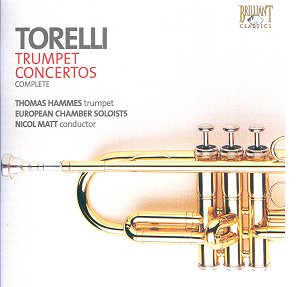Torelli was born
in Verona but studied composition in Bologna under Perti whilst
becoming an orchestral string player. He composed concertos
fairly extensively in various forms using titles such as ‘sinfonia’,
‘concerto’ and ‘sonata’ rather arbitrarily. The above listing
may look confusing but essentially here we have nineteen trumpet
concerti and three for two trumpets, generally with strings
and harpsichord accompaniment.
The format is quite
varied and these works have three, four or five movements. Notably,
the Sinfonia G.11 has a middle (of three) movements lasting
thirty seconds marked “presto/adagio” and there is precisely
fifteen seconds at each tempo. The Sinfonia in D G.23 is perhaps
the most striking work and also one of the more substantial
at over six minutes! The two discs of just under 100 minutes
have no less than 74 tracks, the longest of which fails to break
the two and half minute barrier. Whilst such “minimalism” precludes
major substance, these are attractive works which are full of
invention and which are grateful for the solo instruments.
Apart from the prevailing
importance of the trumpet in Bologna in the late 17th
century, it is unclear to me why (or for whom) Torelli composed
so much for the trumpet. Nevertheless there is no doubting his
importance in this respect and these works seems to have done
more than his other compositions to assure him a place in musical
history.
In performance terms
these are appropriately small-scale (there are about ten orchestral
players in total) and based on modern instruments. Thomas Hammes
is a young orchestral trumpeter currently with the SWR Radio
Symphony Orchestra in Stuttgart and he plays with relish and
fine control. Torelli’s demands are variably onerous and presumably
reflect some instrumental limitations of the time. The orchestral
playing is refined and spirited under another young artist,
Nicol Matt, who chooses not to direct from the harpsichord.
The recorded sound is bright and admirably balanced.
The documentation
consists of a rather woolly essay by Matthieu Kuttler which
suffers from an unidiomatic English translation. The soloists
and conductor are given brief biographies in English (only)
while the orchestra is described in German (only); presumably
this was not intentional. Also, the composer Giacomo Antonio
Perti is incorrectly given as “Petri” in the booklet.
Despite the vagaries
of the documentation, at “Brilliant” (i.e. superbargain) price
this set is excellent value. A highly recommendable way of exploring
some worthwhile late 17th century music. It deserves
the attention of anyone interested in the development of the
trumpet.
Patrick C
Waller

![]() Thomas Hammes (trumpet);
Peter Leiner (trumpet 2)
Thomas Hammes (trumpet);
Peter Leiner (trumpet 2)![]() BRILLIANT CLASSICS 92401
[48:21 + 50:57]
BRILLIANT CLASSICS 92401
[48:21 + 50:57]





